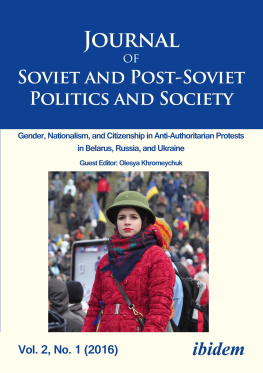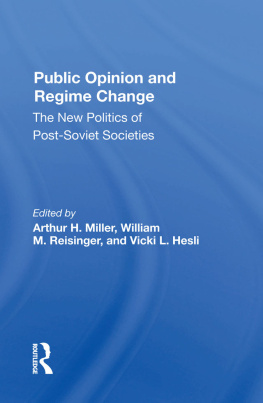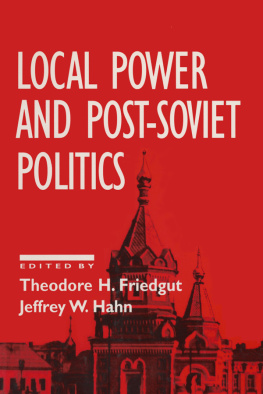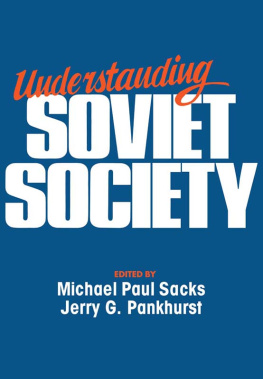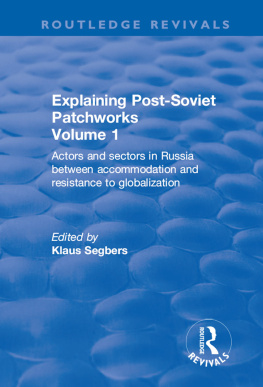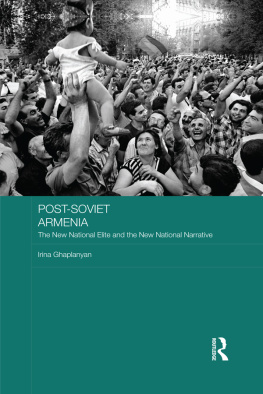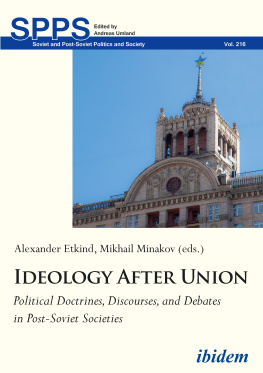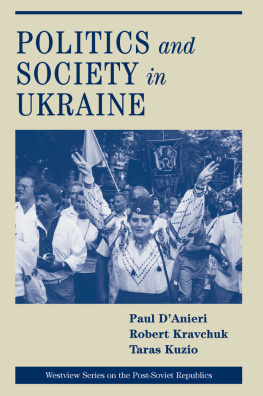Contents
Olesya Khromeychuk
Articles
Olesya Khromeychuk
Tamara Martsenyuk
Darya Malyutina
Evgenia Ivanova
Olenka Dmytryk
Nadia plungian
Olesya Khromeychuk
Iryna Kosovska
Francesca Stella, Lesbian Lives in Soviet and Post-Soviet Russia: Post/Socialism and Gendered Sexualities
Cai Wilkinson
Jenny Kaminer , Women with a Thirst for Destruction: The Bad Mother in Russian Culture
Katherine Bowers
Stephen Amico, Roll Over, Tchaikovsky! Russian Popular Music
and Post-Soviet Homosexuality
Catherine Baker
Irina Mukhina, Women and the Birth of Russian Capitalism:
A History of Shuttle Trade
Laura A. Dean
Marian J. Rubchak (ed.) , New Imaginaries: Youthful Reinvention of Ukraines Cultural Paradigm
Dafna Rachok
Russell Scott Valentino, The Woman in the Window: Commerce, Consensual Fantasy, and the Quest for Masculine Virtue in the Russian Novel
Connor Doak
Valerie Sperling, Sex, Politics, and Putin: Political Legitimacy in Russia
Rustam Gadzhiev
Jennifer Utrata, Women without Men: Single Mothers and Family Change in the New Russia
Anna Shadrina
** *
Steven Lee Myers, The New Tsar: The Rise and Reign of
Vladimir Putin
Anders slund
Thomas W Simons, Jr (ed.), Islam in Eurasia: A Policy Volume
Shahram Akbarzadeh
Ieva Astahovska et al (eds.), Revisiting Footnotes: Footprints
of the Recent Past in the Post-Socialist Region
Ulrike Gerha rdt
Introduction
Olesya Khromeychuk
In April 2014, a senior Russian politician who is known better for his scandalous outbursts than his political work was filmed ordering two male aides to violently rape a female journalist, Stella Dubovitskaia , who had asked a slightly prickly question about the crisis in Ukraine during a press conference inside the state Duma. [1] Noticing that the journalist in question was not only a female, but a pregnant female, Vladimir Zhirinovskii found another reason to silence her: [t]his is no place for you if youre pregnant. [] Pregnant women should not show up at work. Sit at home and look after your child, got that? yelled Russias former deputy speaker of the Duma. [2] He then added that it was thanks to women like the journalist that the protests in Ukraine had erupted, and assessed the female protesters as suffering from uterine frenzy . Without that uterine frenzy there wouldnt have been Maidan , concluded the leader of the Liberal Democratic Party of Russia. [3] The politicians diagnosis was echoed by Russias National Television ( NTV ), one of the main state-backed channels, which produced a program dedicated to the women of the Maidan with the unambiguous title The Furies of the Maidan : Sex, Psychosis, and Politics. [4] This televised celebration of open misogyny demonized a number of female political figures, such as Olha Bohomolets , Lesia Orobets , Iryna Farion , and Tetiana Chornovol who gained some visibility during the protests in Ukraine, but who have little in common apart from their gender. In a pseudo-scientific analysis of the womens political and personal lives, the programs experts labelled the women as furies, whose unsatisfied libido drove them into the protest movement. [5]
Both Zhirinovskii and the NTV documentary reduced the women who dared enter the public and the political spheres to their uteruses. The womens desire to participate in political life was equated with an exaggerated and unsatisfied sexual appetite. They were presented as animals who needed to be tamed or as people suffering from an illness that needed to be cured. It is remarkable that such a description of half of the Ukrainian protesters could be voiced by a high-ranking politician and supported on national television in the twenty-first century with no repercussions for either of the two parties. It is precisely because such a reduction of politically active women continues to be possible that this special issue is not only timely, but also urgent.
This special issue is based on papers given at a workshop held at the University of Cambridge in June 2015. [6] The participants included not only scholars who study the region, but also academics and activists who have participated directly in anti-authoritarian protest movements. The workshop brought together scholars and practitioners who dealt with the questions of gender inequality first hand and who could share their in-depth knowledge with each other. The workshop was of great benefit to those present, but, as is often the case with a discipline that positions itself, deliberately or otherwise, outside of the mainstream, the knowledge at the workshop was mostly shared among the converted . Therefore, it was agreed that the findings of the workshop should be voiced through a publication that could bring the discussions of gender to a larger audience. The Journal of Soviet and Post-Soviet Politics and Society seemed like a perfect outlet for this task. The articles that comprise this issue deal with questions that receive little attention outside of the field of gender studies. By disseminating them through a publication that deals with broad issues relevant to the region we hope to reach a wider readership, and demonstrate that the understanding of gender perceptions, relations, and representations is vital for the understanding of the region and its political, social, and cultural processes.
The focus on protest movements is highly suitable for this purpose. Revolutions, protests, and demonstrations tend to arise when there is an urgent need for change, and when a critical mass of the population is ready to bring this change about. The countries that form the focus of this issue have all witnessed numerous attempts to bring about such changes in the post-Soviet years of their existence. Those who set the agendas of the protests, participate in them, and deliver the outcomes often include a cross-section of their respective societies, yet the general perception of the protest activity tends to be associated with certain individuals, usually heteronormative males, who become the emblems of the anti-authoritarian struggle of their nations, and who rarely aim to represent the interests of groups that also stand against authoritarian regimes, but which, at the same time, are against patriarchy. Alexei Navalny , for instance, one of the leaders of the opposition in Russia, who describes himself as nationalist democrat, is a fierce critic of Vladimir Putin, yet as an Orthodox believer he condemned the actions of his fellow critics of Russias President, Pussy Riot, as repulsive, stating that he would be angry if his daughter behaved similarly. [7] At the same time, Navalny argued that the women of Pussy Riot should not have been imprisoned, not because he supported their protests, but because he believed that it was not right to keep mothers of small children in prison. [8] By comparing his fellow protesters to either naughty daughters or pitiful mothers, the leader of the opposition, similarly to Zhirinovskii , deprived them of their political agency. Examples of similar attitudes from other countries discussed in this issue serve as evidence that even though women can be politicians, protesters, and revolutionaries, the attitude towards them is shaped by the perceptions of gender that are prevalent in society.
All papers in this issue discuss protest activity in one form or another. Given the temporal proximity of the Maidan events in Ukraine, it is unsurprising that this particular protest movement is discussed in several contributions. Tamara Martsenyuks paper and my own article look at various groups within the Maidan protest movement. Martsenyuk examines the experiences of LGBT activists during the Maidan and demonstrates that, in order to be able to participate in what has been termed the Revolution of Dignity unhindered by their fellow-protesters, some of them chose to suspend their LGBT activism for the duration of the revolution, while others promoted the notion of the correct gay identity and the idea of homonationalism . Martsenyuk also assesses the outcomes of the Maidan protests and the degree of their success in defending human rights, including those of the LGBT community. In my own article I examine the use of the protest space through the lens of gender. While women were certainly present at the Maidan , the space they occupied was often regimented by the male protesters. That said, the female protesters managed to find certain pores in the physical and ideological boundaries of the Maidan and succeeded in going beyond them, both in the process of challenging the patriarchal order, and while obeying its rules. Comparing perceptions and representations of gender relations on the Maidan with those in other protests, in particular the Arab Spring, I conclude that the active participation of women in the protest movements does not necessarily guarantee their liberation.

